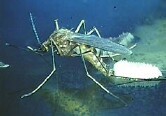
MONDAY, Feb. 10, 2014 (HealthDay News) — West Nile virus-related hospitalizations and follow-up in the United States cost $778 million in health care expenses and lost productivity from 1999 through 2012, which is much higher than previously reported, according to a new study.
That works out to a cost of about $56 million a year over the 14 years examined by the U.S. Centers for Disease Control and Prevention researchers.
West Nile virus is transmitted by mosquitoes. About one in five people infected with the virus will develop symptoms such as fever, joint pain and headache. However, about one in 150 will develop a serious nervous system (neurologic) condition such as encephalitis or meningitis and require hospitalization, according to an American Society of Tropical Medicine and Hygiene news release.
The researchers examined more than 37,000 cases of West Nile virus reported to the CDC from 1999 through 2012. They found that more than 16,000 patients developed neurologic disease, more than 18,000 were hospitalized and more than 1,500 died. People older than 50 are more likely to develop severe neurologic disease if they’re infected with the West Nile virus, the release noted.
The number of West Nile virus disease cases reported to the CDC is likely fewer than the actual number that occurred in the United States since 1999, according to the news release.
For the new study, researchers examined the costs of initial hospitalization of 80 patients and the long-term direct and indirect costs over the next five years. Those costs included medications, doctor visits, and time missed from work or school.
“We believe that previous costs associated with West Nile virus disease have been underestimated because they’ve predominantly focused on the costs of the initial illness,” study lead author Dr. J. Erin Staples, a CDC medical epidemiologist, said in the news release.
“Many hospitalized patients will incur additional medical and indirect costs, and these need to be figured into the burden of [West Nile virus] disease,” she said. “Only with accurate figures can public health, academic, and industry officials determine the cost effectiveness of local mosquito-control measures or of developing new drugs and vaccines.”
The costs associated with West Nile virus infection varied widely depending on what types of complications patients developed, according to the study published online Feb. 10 in the American Journal of Tropical Medicine and Hygiene.
“We broke down costs by clinical syndrome and were surprised by what we found,” Staples said. “While patients with meningitis had shorter hospital stays than others with neurological syndromes, they were also younger and more likely to miss work, which translated to a higher economic cost in lost productivity.”
Meanwhile, encephalitis patients tended to be older. Because many of them were retired, cost related to lost productivity was lower, she noted.
The first human West Nile virus infections in the United States occurred in New York City in late summer 1999, and the virus spread across the entire continental U.S. in less than five years, according to the release. A number of experimental vaccines are being tested but none is available to the public.
More information
The American Academy of Family Physicians has more about West Nile virus.
Copyright © 2025 HealthDay. All rights reserved.

